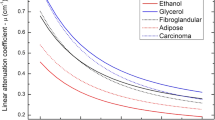Abstract
In this study, paraffin was selected as a base material and mixed with different amounts of CaSO4·2H2O and H3BO3 compounds in order to mimic breast tissue. Slab phantoms were produced with suitable mixture ratios of the additives in the melted paraffin. Subsequently, these were characterized in terms of first half-value layer (HVL) in the mammographic X-ray range using a pulse-height spectroscopic analysis with a CdTe detector. Irradiations were performed in the energy range of 23–35 kVp under broad beam conditions from Mo/Mo and Mo/Rh target/filter combinations. X-ray spectra were acquired with a CdTe detector without and with phantom material interposition in increments of 1 cm thickness and then evaluated to obtain the transmission data. The net integral areas of the spectra for the slabs were used to plot the transmission curves and these curves were fitted to the Archer model function. The results obtained for the slabs were compared with those of standard mammographic phantoms such as CIRS BR series phantoms and polymethylmethacrylate plates (PMMA). From the evaluated transmission curves, the mass attenuation coefficients and HVLs of some mixtures are close to those of the commercially available standard mammography phantoms. Results indicated that when a suitable proportion of H3BO3 and CaSO4·2H2O is added to the paraffin, the resulting material may be a good candidate for a breast tissue equivalent phantom.




Similar content being viewed by others
References
NCRP (1988) Report No. 99, Quality assurance for diagnostic imaging, ISBN 0-929600-00-2
Perry N, Broeders M, Wolf C de, Törnberg S, Holland R, Karsa L von (2013). European guidelines for quality assurance in breast cancer screening and diagnosis. 4th edition
White DR (1977) The formulation of tissue substitute materials using basic interaction data. Phys Med Biol 22:889
Poletti ME, Gonçalves D, Mazzaro I (2002) X-ray scattering from human breast tissues and breast-equivalent materials. Phys Med Biol 47:47–63
Argo William P, Hintenlang Kathleen, Hintenlang David E (2004) A tissue-equivalent phantom series for mammography dosimetry. J Appl Clin Med Phys 5:112–119
Hammerstein GR, Miller DW, White DR, Masterson ME, Woodard HQ, Laughlin JS (1979) Absorbed radiation dose in mammography. Radiology 1304:85–91
NIST (2016). NIST web page:http://physics.nist.gov/PhysRefData/XrayMassCoef/tab4.html. Accessed 31 Jun 2016
Bliznakova K, Buliev I, Kolev J, Bliznakov Z, Kolev N (2013). Study of suitability of new materials for use with physical breast phantoms, The 4th IEEE International Conference on E-Health and Bioengineering—EHB 2013
Lam AR, Ding H, Molloi S (2014) Quantification of breast density using dual-energy mammography with liquid phantom calibration. Phys Med Biol 59:3985–4000
Archer BR, Fewell TR, Conway BJ, Quinn PW (1983) Diagnostic X-ray shielding design based on an empirical model of photon attenuation. Health Phys 44:507–517
Cubukcu S, Yücel H (2015) Development of breast tissue equivalent phantom made from paraffin with some additives and its characterization by using X-ray spectroscopy. ECR 2015 Poster. doi: 10.1594/ecr2015/C-0145. Web page: http://posterng.netkey.at/esr/viewing/index.php?module=viewing_poster&task=&pi=127857. Accessed 02 Jun 2016
Acknowledgments
This work was supported by TUBİTAK Project No:115S108 “Development of a tissue equivalent phantom used for quality control tests of mammography systems and its characterization by using X-ray spectroscopy”. This work is also a part of Ph.D. dissertation study of Mrs. Solen Cubukcu in Ankara University, Turkey.
Author information
Authors and Affiliations
Corresponding author
Ethics declarations
Conflict of interest
The authors have no conflicts of interest.
Rights and permissions
About this article
Cite this article
Cubukcu, S., Yücel, H. Characterization of paraffin based breast tissue equivalent phantom using a CdTe detector pulse height analysis. Australas Phys Eng Sci Med 39, 877–884 (2016). https://doi.org/10.1007/s13246-016-0487-1
Received:
Accepted:
Published:
Issue Date:
DOI: https://doi.org/10.1007/s13246-016-0487-1




